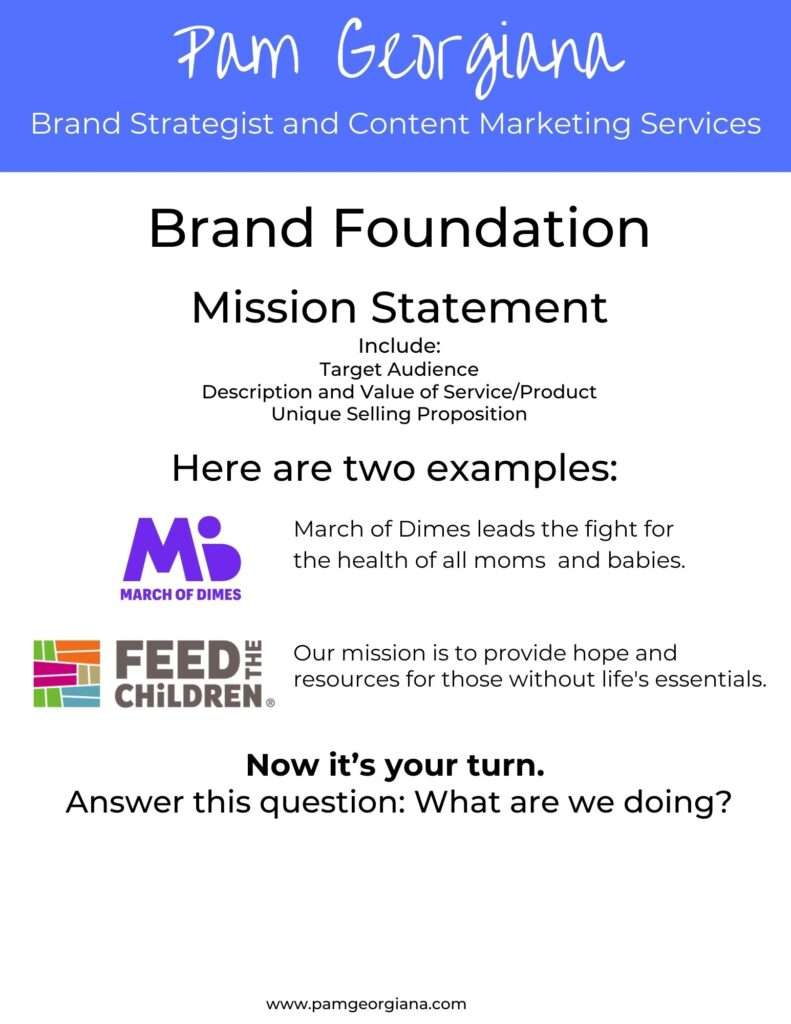
As you may have read here on this blog or on my Content Marketing Musings newsletter, I’ve chosen the words Open, Position, and Balance as my focus words for 2024. To me, these words represent the things I need to do this year to optimize my time, deepen my business client list, and strengthen my mental health. If I make all of my decisions through the lens of one or more of these focus words, I’ll be successful.
For Position, I plan to be more proactive and deliberate about the clients I want and the work I do. I love all of my clients and the work I do for them but I do have favorites. I love working with nonprofits and faith-based organizations. I also love building brands. So, I want to position myself as an expert on assisting these types of organizations in building or revamping their brands. However, I know branding is not something that many nonprofit leaders feel they need. I know there are some hurdles to overcome in awareness and understanding. The first step is to help leaders understand how important branding is to mission-driven organizations.
Why is branding important to nonprofits and faith-based organizations?
Defining an identity as a mission-driven organization dedicated to serving a specific need can deeply resonate with those you want to serve and engage those who want to serve with you.
Without a strong brand, that mission can come across as inauthentic, inconsistent, and ineffectual. A proactive brand strengthens the present-day mission AND grows the future impact of the organization.
So, I’m building some resources and templates to bridge that gap. I will use this space and my newsletter to highlight some of them this month. I showed my brand pyramid framework in this week’s Content Marketing Musings. If you haven’t seen it, check it out here. If you haven’t read it, here’s the TL:DR version.
The Brand Pyramid
A brand pyramid is a strategic blueprint that becomes the framework for your brand’s identity. It encompasses every element that collectively defines, aligns, and guides your brand’s presence in the market. It serves as a guide for all company decision-making, ensuring that your organization presents a unified and compelling image to your internal and external stakeholders.

At the base of that pyramid is an organization’s mission, vision, purpose, and values. These essential building blocks make up the foundation of a solid brand. These details are not just pretty words on a business plan or website. Without them, a brand is often built on meaningless and flimsy marketing or sales details that are not authentic and do not stand up to competition in the marketplace. If a nonprofit leader and staff do not understand and embrace these building blocks, how can they expect their stakeholders to care about their organization?
Let’s talk about the all-important mission statement for nonprofits and faith-based organizations.
The Mission Statement
A mission statement is an active statement.
It conveys what an organization does on a day-to-day basis, who it serves, and what makes it unique. It serves as a guiding statement that communicates the organization’s core objectives. A nonprofit’s mission statement must be transparent, inspiring, and reflective of the organization’s unique purpose. The language should resonate with the organization’s stakeholders, including donors, volunteers, and the communities it serves. The mission statement is a foundation for the nonprofit’s strategic direction and guides its actions to pursue its goals. It is also crucial in building an active and engaging brand.
A mission statement provides clarity.
Clarity about why the organization exists, what it stands for, and the principles that guide its actions. It helps create a strong foundation for the brand’s identity. A compelling mission statement has the power to inspire and motivate both internal and external stakeholders. It gives employees a sense of purpose and a shared goal, fostering a positive and unified company culture. Externally, it can resonate with clients, volunteers, donors, and partners, creating a sense of connection and loyalty.
A mission statement builds trust.
Trust is a valuable asset in building a strong organization. A clear and authentic mission statement builds trust and credibility with stakeholders. When the brand consistently demonstrates its commitment to the stated mission, it reinforces trust among stakeholders and the broader community. It also contributes significantly to how the organization is perceived by the public. It can resonate with the values and aspirations of the target audience. Conversely, a misalignment between the mission statement and actual actions can lead to a negative perception.
A mission statement is a foundational element of any brand.
It influences internal culture, external perception, and strategic direction. It is a powerful tool that communicates the essence of the organization and shapes its identity in the eyes of the world.
If you’re interested in working on your mission statement, here’s a downloadable worksheet to share with your team.

The heart of any nonprofit or faith-based organization’s brand is its mission statement. It’s not just a collection of words; it’s a declaration of action, a compass guiding every step toward a better, more impactful future. Feel free to dive into the downloadable worksheet provided, spark conversations within your team, and unleash the power of a compelling mission statement. Remember, it’s not just about what you say; it’s about how you live your mission daily, creating a brand that stands the test of time and leaves a lasting impact on those you touch.
Yet, it’s just the beginning of a brand’s foundation. I’ll talk about the other building blocks in upcoming posts. If you’d like to speak with me one-on-one about your organization’s brand, please contact me on my contact page. I’d love to hear from you.
